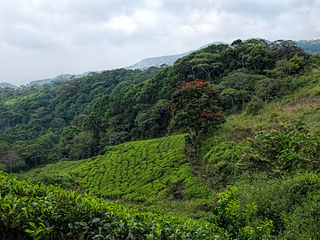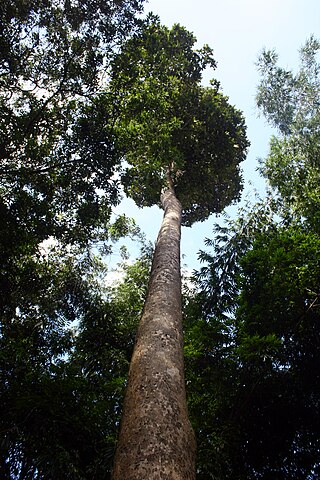
The Sri Lanka blue magpie or Ceylon magpie is a brightly coloured member of the family Corvidae, found exclusively in Sri Lanka. This species is adapted to hunting in the dense canopy, where it is highly active and nimble. Its flight is rather weak, though, and is rarely used to cover great distances. In spite of the Sri Lanka blue magpie's ability to adapt to the presence of humans, it is classified as vulnerable to extinction due to the fragmentation and destruction of its habitat of dense primary forest in the wet zone of southern Sri Lanka.

Sinharaja Forest Reserve is a forest reserve and a biodiversity hotspot in Sri Lanka. It is of international significance and has been designated a Biosphere Reserve and World Heritage Site by UNESCO.

The Sri Lanka hanging parrot is a small parrot which is a resident endemic breeder in Sri Lanka.

The Serendib scops owl is the most recently discovered bird of Sri Lanka. It was originally located by its unfamiliar poo-ooo call in the Kitulgala rainforest by prominent Sri Lankan ornithologist Deepal Warakagoda. Six years later, it was finally seen by him on 23 January 2001 in Sinharaja, and formally described as a species new to science in 2004. Apart from Sinharaja and Kitulgala, it has also been found at Runakanda Reserve in Morapitiya and Eratna Gilimale. It is known as පඩුවන් බස්සා in Sinhala.

The environment of Sri Lanka exhibits a remarkable biodiversity.

Ratnapura is a district of Sri Lanka in the Sabaragamuwa Province.
Travancore flying squirrel is a flying squirrel found in Sri Lanka and the Western Ghats of South India. Travancore flying squirrels were thought to be extinct but were rediscovered in 1989 after a gap of 100 years in Kerala. It was rediscovered in Sri Lanka after 78 years. The animals were reported only in wet and intermediate zones of the island, and had a few sightings in the Sinharaja Forest Reserve.
Kanneliya–Dediyagala–Nakiyadeniya or KDN is a forest complex in southern Sri Lanka. The forest complex designated as a biosphere reserve in 2004 by UNESCO. The KDN complex is the last large remaining rainforest in Sri Lanka other than Sinharaja. This forest area has been identified as one of the floristically richest areas in South Asia. The forest complex is situated 35 km northwest of city of Galle. The rain forest is a major catchment area for two of the most important rivers in southern Sri Lanka, the Gin and Nilwala Rivers. This biosphere reserve harbors many plants and animal species endemic to Sri Lanka.

Crocidura hikmiya is a species of shrew described from the rainforests of Sri Lanka, based on both morphological and molecular data. Its closest sister species is the Sri Lankan long-tailed shrew, another Sri Lankan crocidurine shrew restricted to the high-elevation habitats of the Central Highlands. C. hikmiya has a shorter tail than the Sri Lankan long-tailed shrew. Most of the other characteristics that distinguish the two species are osteological natured .

Dipterocarpus zeylanicus, commonly known as හොර - Hora in Sinhalese and සරල - Sarala or කිරිපලු - Kiripalu, is a species of Dipterocarpus that is endemic to Sri Lanka. A closely related Indian species is Dipterocarpus turbinatus. The Sri Lankan tree is a large tree that grows up to 40 – 45 m tall and 4 – 6 m in circumference. The bark is light pinkish brown or light yellowish brown. Leaves are big and oval, 5 to 8 inches long. The sharp-edged leaves are covered with silver hairy. Flowers bloom in April and seeds have two wings to spread from wind. The bark contains considerable amounts of gray caller oleo resin. D. zeylanicus can be found in moist low country like Ratnapura, Kaluthara, Galle and Mathara districts and also in the Sinharaja rain forest. The tallest trees of Hora in Sri Lanka are found in Udakiruwa village in Lunugala and under great threat of legal/illegal felling. There are many place names which begin with the name of the Hora tree. Even Tamil place names like Norochcholai is said to refer to a clump of Hora trees - i.e., "Horagolla" in Sinhalese.
Protected areas of Sri Lanka are administrated by Department of Forest Conservation and Department of Wildlife Conservation of Sri Lanka.There are 501 protected areas in Sri Lanka. The protected areas that fall under supervision of the Department of Forest Conservation include forests defined in National Heritage Wilderness Area Act in 1988, forest reservations, and forests managed for sustainability. Sinharaja Forest Reserve is an example for a National Heritage forest. There are 32 forests categorized as conservation forests including Knuckles Mountain Range. Strict nature reserves, national parks, nature reserves, forest corridors, and sanctuaries recognized under the Flora and Fauna Protection Ordinance are managed by Department of Wildlife Conservation. Total of all protected areas is 1,767,000 ha. Protected areas in Sri Lanka account for 26.5 percent of the total area. This is a higher percentage of protected areas than in all of Asia and much of the World.

Deforestation is one of the most serious environmental issues in Sri Lanka. Sri Lanka's current forest cover as of 2017 was 29.7%. In the 1920s, the island had a 49 percent forest cover but by 2005 this had fallen by approximately 26 percent. Between 1990 and 2000, Sri Lanka lost an average of 26,800 ha of forests per year. This amounts to an average annual deforestation rate of 1.14%. Between 2000 and 2005 the rate accelerated to 1.43% per annum. However, with a long history of policy and laws towards environmental protection, deforestation rates of primary cover have decreased 35% since the end of the 1990s thanks to a strong history of conservation measures. The problem of deforestation in Sri Lanka is not as significant in the southern mountainous regions as it is in northern and lowland southern Sri Lanka, largely due to the nature of environmental protection.

Field Ornithology Group of Sri Lanka, commonly abbreviated FOGSL, is the Sri Lankan affiliate of BirdLife International. It was founded in 1976 to promote the conservation of birds and preservation of the environment. FOGSL headquarters are situated in the Department of Zoology, University of Colombo, Sri Lanka. Its president is Professor Nihal Dayawansa.

Kalu Ganga is a river in Sri Lanka. The river originates from Horton Plains National Park, reaching the sea at Kalutara after a 129 km (80 mi) journey. The Black River flows through the Ratnapura and the Kalutara District and passes the city Ratnapura. The mountainous forests in the Central Province and the Sinharaja Forest Reserve are the main sources of water for the river. The Edwardian manor, Richmond Castle is on the banks of the river near Kalutara.

The whistling lizard or Sri Lanka agama is a species of lizard in the family Agamidae. It is one of seven Calotes species endemic to Sri Lanka.
Lankascincus taylori, commonly known as Taylor's tree skink, is a species of lizard in the family Scincidae. The species is endemic to the island of Sri Lanka.
Dendrelaphis oliveri, commonly known as Oliver's bronzeback, is a species of nonvenomous arboreal snake in the family Colubridae. The species is endemic to Sri Lanka. It is considered to be the rarest of the Sri Lankan Dendrelaphis species on account of there being only a single recorded specimen.
The Nilwala is a river in Southern Province in Sri Lanka. It originates in Sinharaja Forest Reserve and discharges into the sea at Matara.
Malwattage Celestine Violet Savitri Gunatilleke is professor emeritus at the University of Peradeniya in Sri Lanka's Central Province. She has had a long career in forest ecology and has been a leader in quantitative ecology and education. Most of her research has focused in the Sinharaja rain forest in Sri Lanka. She considers her main contribution to forest ecology to be spreading the idea that successful forest conservation depends on local conservationists. In line with this, she is proud of her students and their accomplishments in the field of conservation.
Bhagya Abeyratne, also known as Bhagya Abeyrathna is a Sri Lankan environmental activist. In March 2021, she received wide media attention for exposing the deforestation of the UNESCO world heritage site of the Sinharaja Forest Reserve.











